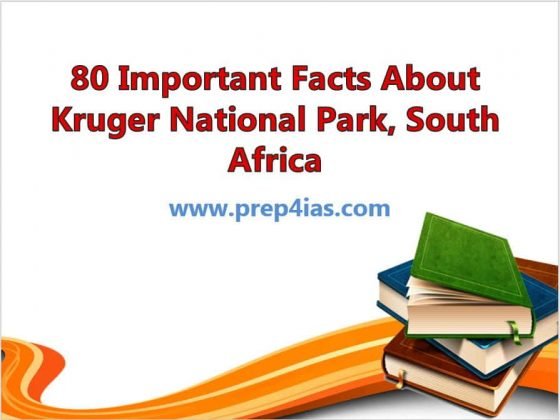In this article, we will look into some of the Important Facts About Kruger National Park, South Africa. The world famous Kruger National Park is probably the oldest National Park in Africa. It was proclaimed as a no-hunting zone by Transvaal Republic government in 1898 and then later proclaimed as a National Park in 1926. It not only has the wide variety of flora and fauna but also more than 250 sites of Cultural heritage and 300 archaeological sites of Stone Age. Every year thousands of tourists comes here from all around the World. We will see some of the more important facts about this park in below section.
What is Game Reserves
A Game reserve is a large area of land where wild animals live safely or are hunted in a controlled manner for Sport. It is different from a Natural reserve in the way that hunting is prohibited in Natural reserve otherwise both are almost same.

Important Facts About Kruger National Park, South Africa
- Kruger National Park is located in South Africa.
- It is one of the largest game reserves in Africa.
- This park's administrative headquarters are in Skukuza.
- Kruger National Park is named after Paul Kruger, the president of Transvaal in 1884, who saw a need to protect the region's animal population from over-hunting.
- Kruger was born on a small farm in 1825. When the Great Trek started in 1836, his father uprooted the family and moved them to what was known as the Transvaal, where they settled in a town called Rustenburg.
- At first, the areas of the park were protected by the government of the South African Republic in the year 1898.
- Kruger National Park finally received international acclaim when Princess Elizabeth and Princess Margaret visited the Park on their royal tour of South Africa and stayed in one of the first luxury lodges built in the reserve.
- Scottish-born James Stevenson-Hamilton was appointed as the first Warden of the Park in 1902 when it was still known as the Sabie Game Reserve.
- In year 1926, it became South Africa's first national park.
- An area of 19,623 km sq is covered by this park in the territory of Limpopo and Mplumalanga in Northeastern South Africa.
- It extends 40 mi from east to west and 220 mi from north to south.
- Kruger National Park now comes under the Great Limpopo Transforntier Park, a peace park that links Kruger National Park with the Gonarezhou National Park in Zimbabwe, and with the Limpopo National Park in Mozambique.
- The park is part of the Kruger to Canyons Biosphere, an area designated by the United Nations Educational, Scientific and Cultural Organisation (UNESCO) as an international Man and Biosphere Reserve. The Kruger to Canyons Biosphere is the third largest biosphere reserve in the world.
- This park is one of the largest national parks in the world.
- The highest point in this park is a hill called Khandzalive.
- Sabie, Olifants, Crocodile, Letaba, Luvuvhu and Limpopo rivers are several rivers which run through the park from west to east.
- There are more than 1800 km of groomed roads for touring Kruger National Park.
- This park has a subtropical climate. It is common for summer temperatures to surpass 100 degrees Fahrenheit.
- Vegetation in Kruger National Park includes a variety of trees, bushes, grazing grasses, and shrubs.
- There have been at least 517 different bird species identified at Kruger National Park.
- Six species are of particular interest because of vulnerability to changes in habitat or their need for a lot of space. There are referred to as the 'Big Six Birds'.
- The ground hornbill, kori bustard, saddle-billed stork, martial eagle, Pel's fishing owl, and the lappet-faced vulture are included in the Big Six Birds at Kruger National Park.
- African lion, African leopard, African elephant, Cape buffalo, and the black and white rhinos are the five big game animals which are found in this park.
- More than 27,000 African buffalo, 12,000 elephants, and over 1000 leopards living in this park.
- Zebras, Cheetahs, Giraffes, Hippos, Crocodiles, African wild dogs, Bushbacks, Elands, Kudus, spotted Hyenas, Impalas Waterbucks and wildebeest are also included in the wildlife population in Kruger National Park. More on wikipedia.
- More than 114 Known species of reptiles living in this park which includes the African rock python and the Black Mamba.
- There are 49 species of fish that can be found in the waters of this park.
- Here, more than 650 park rangers were work as an anti-poaching unit.
- Drones and a dog unit have been added to the team's equipment to help catch poachers in the Kruger National Park.
- There are 21 rest camps and also designated private lodges and bush camps are located in various locations at this park, where tourists can stay.
